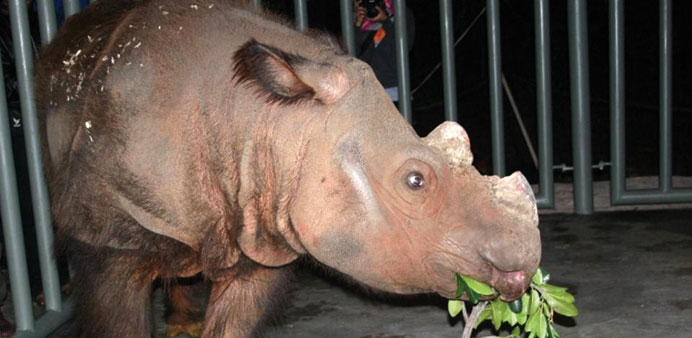AFP/Jakarta
A rare, US-born Sumatran rhino arrived yesterday at his new home in Indonesia, an official said, where it’s hoped he will find a mate and give his critically endangered species a shot at survival.
Harapan, an eight-year-old male whose name means “Hope”, arrived at a specialist rhino sanctuary on Sumatra island at dawn after a long journey from a zoo in Cincinnati.
A senior biodiversity conservation official in Indonesia’s forestry ministry said the rhino was “adapting well” after travelling 36 hours by air, sea and land to reach to the national park.
“He is healthy and has a great appetite,” Bambang Dahono Adji said.
“We noticed this morning he was lapping up all the leaves. Being Sumatran, perhaps he preferred local fare, like rice instead of cheese,” he joked.
Sumatran rhinos are among the rarest in the world, with just 100 believed to still exist.
Harapan was the last remaining rhino of his kind in the US, but without a mate there it was decided he should return to Sumatra to have a chance at producing offspring.
His older brother, Andalas, also moved from a zoo in Los Angeles to the Sumatran Rhino Sanctuary in Way Kambas National Park in 2007.
Since then, he’s fathered a calf at the park, with a second offspring expected in May.
Harapan will be quarantined for just over two weeks before entering the sanctuary, Adji said, where it’s hoped he will follow in his older brother’s footsteps and mate with one of three female rhinos there.
“Like his brother, we hope he will be able to breed and boost the Sumatran rhino population here,” Adji said.
Rhino experts welcomed news of Harapan’s return to his ancestral homeland, especially given the desperation in recent years as the species’ future looked bleaker than ever.
With few alternative options, the Cincinnati Zoo took the controversial step in 2013 of trying to mate Harapan with his older sister Suci. The female died the following year in yet another blow for conservationists trying to save the species.
“It’s good news that he’s (Harapan) here in Indonesia to mate with unrelated females,” said Widodo Ramono, head of the Rhino Conservation Foundation of Indonesia.
“Inbreeding would cause genetic degeneration, which brings problems such as illnesses and defects.”
Another forestry ministry official Andhika Respati said Harapan’s transition out of captivity would come with challenges, though a vet and two keepers from Cincinatti accompanied the rhino to offer advice to his new carers.
“One challenge is how to get him used to life and finding food in the forest, as he had been living in the zoo from birth,” Respati said.
“However we think he will adjust just fine.”
Sumatran rhinos are the only Asian rhinoceroses with two horns. They are covered in woolly hair that ranges from reddish brown to black in colour.
While Javan rhinos are considered the world’s rarest rhinos, Sumatran rhinos are under increasing threat by poachers and continue to lose precious forest habitat.

File photo courtesy of the Cincinnati Zoo shows male Sumatran rhino Harapan in his crate upon arrival in Sumatra.


